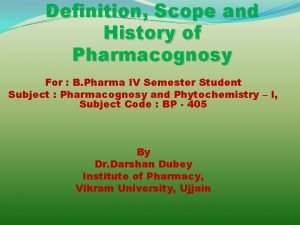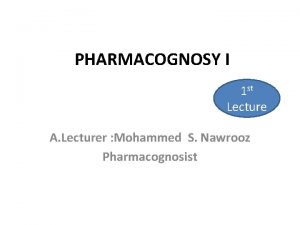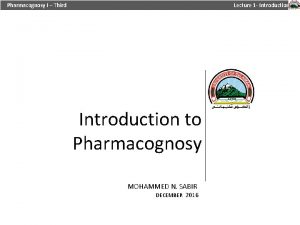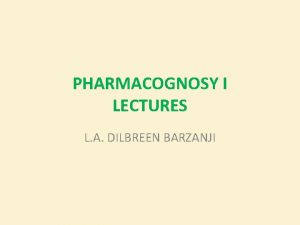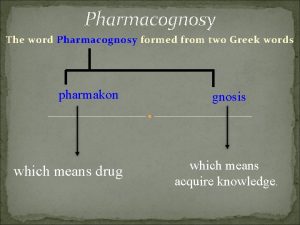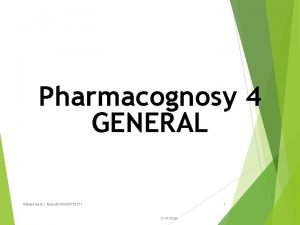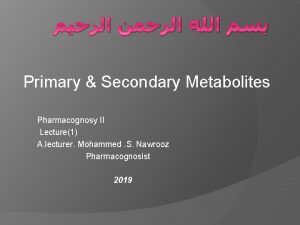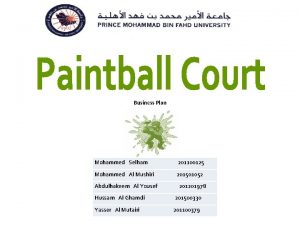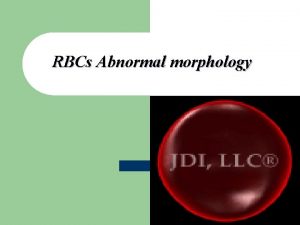PHARMACOGNOSY I 1 st Lecture A Lecturer Mohammed













- Slides: 13

PHARMACOGNOSY I 1 st Lecture A. Lecturer : Mohammed S. Nawrooz Pharmacognosist

The word "pharmacognosy" is derived from the Greek words pharmakon (drug), and gignosco(to acquire a knowledge of) or gnosis (knowledge). The term pharmacognosy as a constituent of scientific branch of pharmacy has been in use for nearly 200 years, and it refers to studies on natural product drugs. It used for the first time in 1811 and 1815 A. D (Anno Domini ) • Pharmacognosy is the oldest of all pharmacy sciences.

• According to American Society of Pharmacognosy it can be defined as “Pharmacognosy is the study of the physical, chemical, biochemical and biological properties of drugs, drug substances or potential drugs or drug substances of natural origin as well as the search for new drugs from natural sources”. • Pharmacognosy is one of the important branches of pharmacy. It deals with “ the study of structural, physical, chemical characters of crude drugs and includes their history, cultivation, collection, storage and use. As well as the search for new drugs from natural sources".

• pharmacognosy includes the extensive study of natural products from plants, , animals( e, g , Honey, Bees wax, Shark liver Oil), minerals(e, g, talc), bacteria(clavulanic acid), fungi(statins) and marine organisms, botanical dietary supplements as well as herbal remedies. It is estimated that 90% of the crude drugs are originated from plant sources while the remaining are from other sources. Pharmacognosy, although closely related to Botany and Phytochemistry, has a natural link with other scientific fields such as Pharmacology, Analytical Chemistry, Microbiology, Plant Tissue Culture, Biotechnology and Genetic Engineering.

The Practice of Pharmacognosy 1. Although pharmacognosy is principally concerned with plant materials, there a small number of animal products which are traditionally also includes other subjects; these include such items as beeswax, gelatin, vitamins, etc. Other natural products such as the antibiotics, hormones and others. 2. Marine organisms, both plant and animal with potent pharmacological actions are receiving increasing attention in the search of new drugs.

3. A lot of natural materials have pharmacological effects, but there also some materials having no pharmacological action which are of interest to pharmacognosists are natural fibers, flavouring and suspending agents, colourants, disintegrants, stabilizers and filtering and support media. 4. Other areas that have natural associations with the subject are poisonous and hallucinogenic plants, allergens, herbicides, and insecticides.

FOR YOU

There are several reasons which can be mentioned to explain the increased interest in natural products and pharmacognosy: 1. search for new targets for drug development. 2. biotechnology for the production of pharmaceuticals. 3. validation of traditional medicines. 4. increased interest in phytotherapy. Three major areas of interest for the pharmacognosist: 1. studies of new biologically active natural products. 2. production of drugs from natural origin, including new methods such as biotechnology. 3. quality control of drugs from natural origin.

Plant organs that contain the natural products used in pharmacy: 1. whole plant. 2. aerial parts or herb. 3. leaf. 4. flower. 5. fruit. 6. bark. 7. root. 8. rhizomes. 9. bulb( a short stem like onion).

Vegetable drugs can be arranged for study under the following headings: 1. Alphabetical: either Latin or vernacular names may be used. 2. Taxonomic: the drugs are arranged according to the plants from which they are obtained, in classes, orders, families, genera and species. 3. Morphological. The drugs are divided into groups such as the following: leaves, flowers, fruits, seeds, herbs , woods, barks, rhizomes, roots (known as organized drugs) extracts, gums, resins(thick liquid exudates), oils, fats and waxes (known as unorganized drugs).

• 4. Pharmacological or Therapeutic: . This classification involves the grouping of drugs according to the pharmacological action of their most important constituent or their therapeutic use. • 5. Chemical or Biogenetic: The important constituents, e. g. alkaloids, glycosides, volatile oils, etc. , or their biosynthetic pathways, form the basis of classification of the drugs. This is a popular approach when the teaching of pharmacognosy is phytochemically based.

THE SCOPE (APPLICATIONS)OF PHARMACOGNOSY: 1)The most important application of Pharmacognosy includes the knowledge about the history, cultivation, collection, standardization, transfer and storage of drugs and economic substances affecting the health of human and other animals. 2)The drug-drug, drug-food interactions are studied in Pharmacognosy which help us to avoid the unwanted effects or severe interactions and hence help in obtaining the optimal therapeutic outcomes. 3)The Pharmacognosy has played an important role in the development of various departments of the science. It includes plant taxonomy, plant pathology, plant genetics, phytochemistry, tissue culture technique, and phytotherapy.

Some Definitions • Extraction : separation of a desired substance when it is mixed with other substances. • Medicinal plants : Plants have the ability to synthesize a wide variety of chemical compounds that are used to perform important biological functions. • Secondary metabolites: are organic compounds that are not directly involved in the normal growth, development, or reproduction of an organism. There absence not causes death to the plant. • Purification : is the process of making something pure.
 Lecturer's name or lecturer name
Lecturer's name or lecturer name What is a pharmacognosy definition
What is a pharmacognosy definition What is the scope of pharmacognosy
What is the scope of pharmacognosy 01:640:244 lecture notes - lecture 15: plat, idah, farad
01:640:244 lecture notes - lecture 15: plat, idah, farad Pearson lecturer resources
Pearson lecturer resources Lecturer in charge
Lecturer in charge Good morning teacher
Good morning teacher Designation of lecturer
Designation of lecturer Spe distinguished lecturer
Spe distinguished lecturer Cfa lecturer handbook
Cfa lecturer handbook Photography lecturer
Photography lecturer Gcwak
Gcwak Physician associate lecturer
Physician associate lecturer Lecturer asad ali
Lecturer asad ali

